HOME >> CHINA
Poverty in China’s ethnic minority concentrated regions sees major drop
Source:Global Times Published: 2019/9/4 20:12:01

Villagers apply grafts to kumquat seedlings at a greenhouse in Gulantun Village in South China's Guangxi Zhuang Autonomous Region, April 12, 2019. (Xinhua/Huang Xiaobang)
The number of people living in poverty in eight ethnic minority concentrated provinces and regions has fallen from more than 30 million to 6 million in the past six years, the State Ethnic Affairs Commission said on Tuesday.
These provinces and regions include the Inner Mongolia Autonomous Region, the Ningxia Hui Autonomous Region, the Xinjiang Uyghur Autonomous Region, the Tibet Autonomous Region, the Guangxi Zhuang Autonomous Region, Guizhou Province, Yunnan Province and Qinghai Province.
The incidence of poverty in these regions fell from 31.21 million in 2012 to 6.03 million in 2018, or 20.8 percent to 4 percent.
The production and living conditions of people of all ethnic groups have also improved markedly, according to the commission.
Since the 18th CPC National Congress, the central government has attached great importance to poverty alleviation in ethnic minority areas.
China has stepped up efforts to increase funding and send more people to help impoverished people.
The inspiring news of remote Chinese ethnic minority groups being lifted out of poverty as a whole has proven the advantages of the socialist system in pooling resources for a certain cause, according to the Xinhua News Agency.
Since the launch of these efforts, the state has made ethnic minority areas the focus of poverty alleviation.
Through a series of measures, it has solved the problems of "who should be supported, who should give the support, and how the support should be given" in poverty-stricken areas, the Commission explained.
Letting people of all ethnic groups live good lives is the long-term goal of China's poverty alleviation cause. It aims to completely eradicate absolute poverty by 2020.
Global Times
RELATED ARTICLES:
Posted in: IN-DEPTH